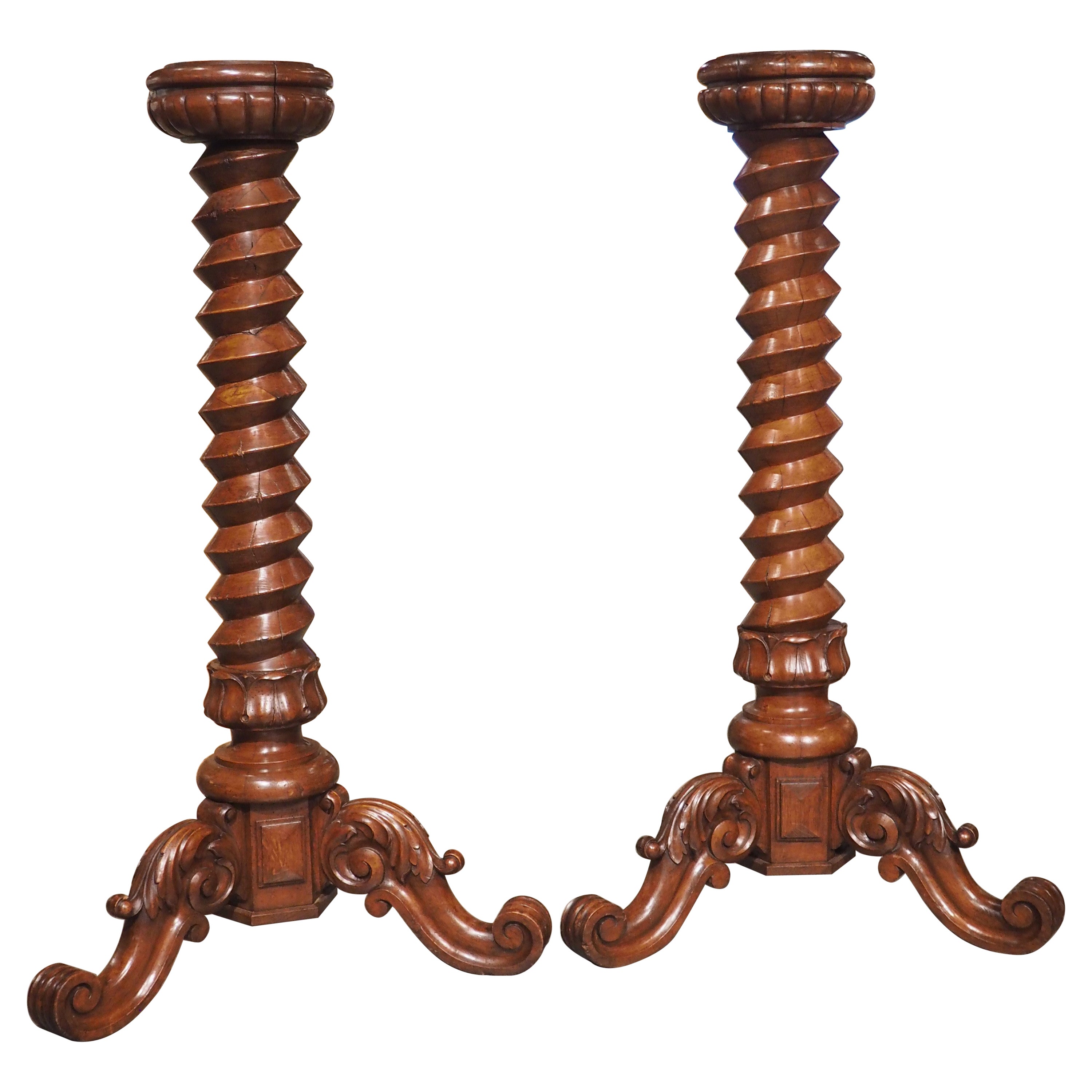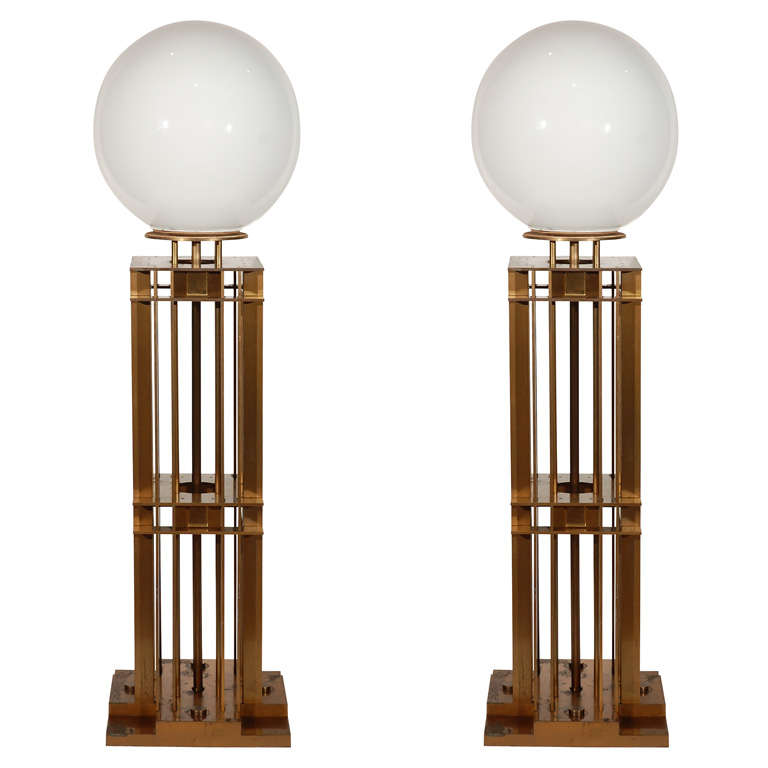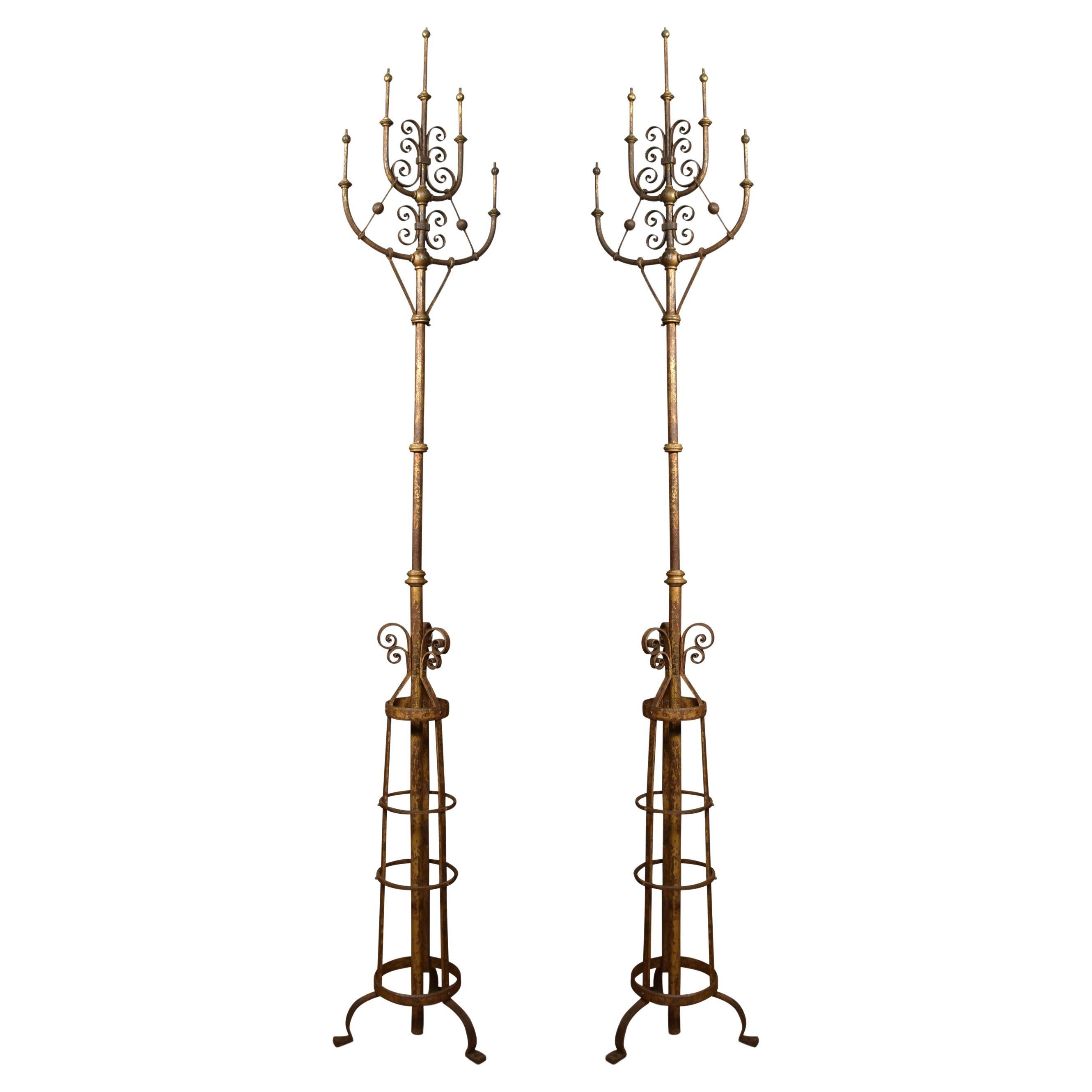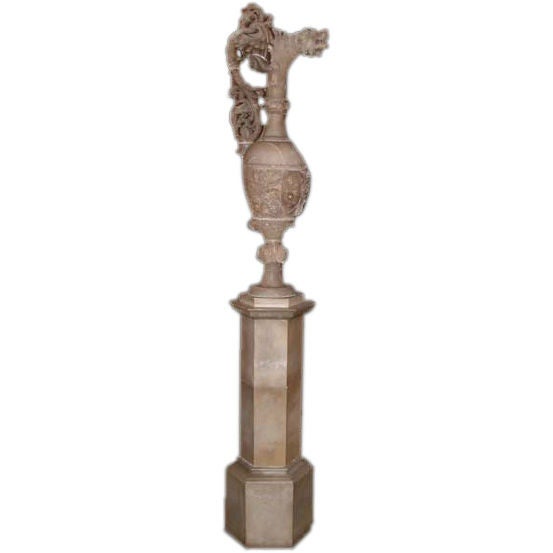Items Similar to Pair of "Bamboo" Stands attr. to H. Cahieux & F. Barbedienne France, circa 1855
Want more images or videos?
Request additional images or videos from the seller
1 of 7
Pair of "Bamboo" Stands attr. to H. Cahieux & F. Barbedienne France, circa 1855
About the Item
A similar model presented at the 1855 Paris Universal Exhibition
Total height : 154 cm (60 5/8 in.) ; Width : 33 x 33 cm (13 x 13 in.)
Cup : height 17 cm (6 ¾ in.)
Beautiful pair of bronze stands also named Bamboo candelabra. Each rests on three claw feet adorned with lion heads and separated with palms. A bamboo shaped shaft arises from this tripod and is topped with three buds supporting a circular red griotte marble top on which stands a cup in the Ancient style decorated with ivy.
The sobriety of the decoration enhances the quality of the bronze cast and the patina shades. The small chains falling from the top animates this work of a sleek design.
The model :
The design of these stands, inspired from Ancient tripods, is a well-known model in Ferdinand Barbedienne’s production as it was reused many times by the bronze-caster. Designed by the head-decorator Henri Cahieux, this model was edited by the Barbedienne Company as soon as 1855, named Ancient candelabra lamp-holder h. 1m35 and was sold 440 francs. From 1875, these stands were commercialised under the name Bamboo candelabra, tripod, lamp-holder and were offered in three heights : 1m90, 1m70 and 1m35. This model of stand could then be found in all catalogues of the Barbedienne Company.
This pair of candelabras allows us to see how F. Barbedienne offered during decades a range of furniture from the designs of his decorator. This type of stand could be seen in different interior decorations of the Second Empire
A model similar to ours was presented by the Barbedienne Company at the 1855 Universal Exhibition. For this occasion Empress Eugénie bought it for her toilet at Saint-Cloud Castle. A watercolor by Fortuné de Fournier made in 1860 shows them, set on both sides of a cheval mirror made by the Fourdinois Company. (see photo attached)
This model pleased the Empress so much that she ordered two other pairs in 1858 for her boudoirs at Compiègne and Fontainebleau Palaces.
Otherwise similar stands took place in the Pompeiian house built in 1856 by the architect Alfred Normand (1822-1909) for Prince Napoléon. Several pictures and engravings of this house show us these candelabras used as lamp-holders. If the Ancient style furniture was designed by Charles Rossigneux (1818-1908), the presence of these stands illustrates that the Barbedienne Company took also part to this work particularly with this model which was successful among the imperial family. (see photo attached)
Biographies :
Henri Cahieux (1825-1854) : head decorator for the artistic bronze-caster Ferdinand Barbedienne, he was destined for a brilliant career, as testified the works of art he sent to the Salons of 1850 and 1853. Most of these pieces were made in the Greek style, which was very fashionable at the time. Victor Champier’s article “Industrial Artists”, which appeared in the Decorative Arts Review (December 1888) echoed the genius of the artist : “Barbedienne had just lost (in 1854), taken by cholera in the prime of life, this young man with such a promising future, whose works, infused with graceful taste, showed him to be a master”. At the 1855 Universal Exhibition in Paris, his lamps which figured as the last testimony of Henri Cahieux, won a medal of honour for Barbedienne’s stand. His succession in the firm was assured by Louis-Constant Sevin (1821-1888) with great success.
Ferdinand Barbedienne (1810-1892) : he created and headed at n°30 boulevard Poissonnière in Paris one of the most famous 19th century artistic bronze casting companies. He owed his reputation to his bronze casting of Ancient and modern sculptures, which subjects came from the greatest European museums, but also to his original bronze works designed in his workshop and reserved for furniture and decoration. In addition to his own production, Barbedienne worked for renowned sculptors such as Barrias, Bosio, Clésinger or Carrier-Belleuse. Awarded with two Council Medals at the 1851 London Universal Exhibition, the Barbedienne Company won at the 1855 Paris Universal Exhibition a medal of honour and eleven cooperator’s medals for the work of his co-workers, designers and chasers. The success of the Barbedienne Company at the diverse international exhibitions earned it several official commissions, as providing ornamental bronze for the Pompeiian house of Prince Napoleon, about 1860, avenue Montaigne in Paris. At the 1867 Universal Exhibition in his capacity as member of and speaker for the Jury, he was non-contestant, but exhibited nevertheless with great success cloisonné and champlevé enamelled pieces. Barbedienne was made an Officer of the Légion d’Honneur in 1867 and Commander in 1878 when he was compared with “a prince of industry and the king of bronze casting”. His glory did not decline with the passage of the time for at the Universal Exhibition of 1889 the critics thanked Barbedienne for the example he set for other bronze-casters by the perfection of his bronzes.
- Attributed to:Henry Cahieux and Ferdinand Barbedienne (Maker)
- Dimensions:Height: 60.63 in (154 cm)Width: 13 in (33 cm)Depth: 13 in (33 cm)
- Sold As:Set of 2
- Style:Greek Revival (In the Style Of)
- Materials and Techniques:
- Place of Origin:
- Period:
- Date of Manufacture:circa 1855
- Condition:Wear consistent with age and use.
- Seller Location:PARIS, FR
- Reference Number:
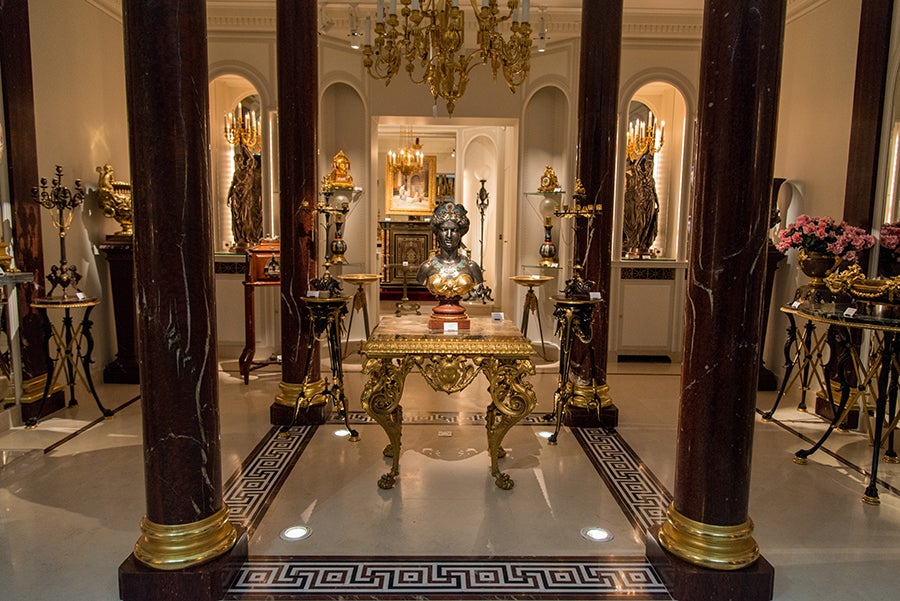
About the Seller
4.9
Vetted Seller
These experienced sellers undergo a comprehensive evaluation by our team of in-house experts.
Established in 1997
1stDibs seller since 2018
74 sales on 1stDibs
Typical response time: <1 hour
Associations
International Confederation of Art and Antique Dealers' Associations
- ShippingRetrieving quote...Ships From: PARIS, France
- Return PolicyA return for this item may be initiated within 7 days of delivery.
More From This SellerView All
- "Bamboo" Stand, Att. to H. Cahieux & F. Barbedienne, France, circa 1855By Henry Cahieux and Ferdinand BarbedienneLocated in PARIS, FRHeight : 197 cm (77,6 in.) ; Base : 42 x 46 cm (16,5 x 18,1 in.) Diameter of the tray : 24 cm (9,4 in.) Important bronze stand with a bamboo shaped shaft topped with three buds supporting a circular top and ending with three claw feet adorned with lion heads and separated with palms. It rests on a moulded triangular-shaped base with cut sides in red Griotte marble. Related work (see attached) : A model similar to ours was presented by the Barbedienne Company at the 1855 Universal Exhibition. For this occasion, the Empress Eugénie bought it for her toilet at Saint-Cloud Castle. A watercolour by Fortuné de Fournier made in 1860 shows them, set on both sides of a cheval mirror made by the Fourdinois Company. This model pleased the Empress so much that she ordered two other pairs in 1858 for her boudoirs at Compiègne and Fontainebleau Palaces. Otherwise similar stands took place in the Pompeiian house built in 1856 by the architect Alfred Normand (1822-1909) for Prince Napoléon. Several pictures and engravings of this house show us these candelabras used...Category
Antique 1850s French Pedestals
MaterialsGriotte Marble, Bronze
- Pair of Neo-Greek Bronze Floor Lamps by F. Barbedienne, France, circa 1860By Ferdinand BarbedienneLocated in PARIS, FRHeight without/with lampshade : 168/185 cm (66,1 / 72,8 in.) ; Base : 43 x 43 cm (16,9 x 16,9 in.) Beautiful pair of neo-Greek floor lamps in bronze with double patina, composed of cylindrical lamps, decorated on the body with a rotating frieze representing women dressed in the Antique style weaving and spinning, surmounted by lampshades with cut sides in red pleated silk with golden braid. They are placed on pedestals from which hang thin chains attached to the slender shaft decorated with stylized leaves and flowers, resting on a tripod base decorated with large palmettes and ending in lion’s paws. The stylistic repertoire used here, composed in particular of palmettes, masks, and nymphs, evokes Greek Antiquity, as does the reuse of forms of furniture and objects such as tripods and antique vases. The rediscovery in the 18th century of the archaeological remains of Pompeii and Herculaneum allowed artists of all disciplines to draw inspiration from Antiquity while reinterpreting it. This trend did not fade and, in the 19th century, many personalities fitted out their interiors with neo-Greek furniture, as was the case for the Maison Pompéienne built in 1856 by the architect Alfred Normand (1822-1909) for Prince Napoleon, or Empress Eugénie who bought from the Maison Barbedienne pedestals inspired by antique tripods. Related work : Pedestal model presented by Maison Barbedienne at the Universal Exhibition in Paris in 1855. On this occasion, Empress Eugénie bought it for her bathroom in the Château de Saint-Cloud. This model pleased the Empress so much that she ordered two other pairs in 1858 for her boudoir in the palaces of Compiègne and Fontainebleau. (see photo attached) Photo showing a floor lamp similar to ours in Empress Eugénie’s bedroom in the Château de Compiègne (Oise), in Architecture intérieure et Décoration en France des...Category
Antique 1860s French Greek Revival Floor Lamps
MaterialsBronze
- Pair of Neo-Greek Gueridons Attr. to L.C Sevin & F. Barbedienne, France, c. 1880By Louis-Constant Sevin, Ferdinand BarbedienneLocated in PARIS, FRPair of patinated and gilded bronze high guéridon attributed to L.C Sevin and F. Barbedienne, with for each of them, three paw feet joined by X shaped stretche...Category
Antique 1880s French Greek Revival Gueridon
MaterialsGriotte Marble, Bronze
- Pair of Neo-Greek Floor Lamps Attributed to G. Servant, France, Circa 1870By Georges Emile Henri ServantLocated in PARIS, FRRare pair of Greek style floor lamps made in patinated bronze attributed to G. Servant, each surmounted of a frosted glass globe engraved of stars and a Greek motif frieze. The body of the vase, decorated with Greek style patterns such as palmets, Greek motif frieze and water leaves, stands on a shaft decorated with deer heads. Fine chains are connected to a delicate butterfly. The set is based on tripod legs with lion claw feet alternating large palmets. Height : 183 cm (72 in.) ; 213 cm (83 3/4 in.) with glass shades ; Diameter : 43 cm (19 2/3in.) Georges Emile Henri Servant (1828-c.1890), who took over his father in 1855 at their foundry, rue Vieille-du-Temple, in Paris, specialized in the production of neo-Egyptian style clocks, very popular in France since 1860’s, and also the making of Greek style decorative objects. He drew considerable attention to the high quality of his bronzes at the 1855 Paris Universal Exhibition and then at the 1862 London Exhibition. At this time Servant exported up to 40% of his production, principally to the United States, where for instance, his clocks were sold with great success by Louis Tiffany Inc. or Hamann & Roche of New York. But his success came really at the 1867 Paris Universal Exhibition, where he was awarded a gold medal for his neo-Greek and Egyptian works (Les Merveilles...Category
Antique 1860s French Greek Revival Floor Lamps
MaterialsBronze
- Pair of Neo-Greek Vase-Candlesticks Attr. to Barbedienne and Levillain, c. 1880By Ferdinand Levillain, Ferdinand BarbedienneLocated in PARIS, FRPair of Greek style amphora shaped candlesticks made of gilded and patinated bronze attributed to F. Levillain and F. Barbedienne. Each flanked with two handles, and decorated with horsemen in relief. Standing on three lion’s feet headed with busts of putti and raised on a red griotte marble base. Ferdinand Levillain (Paris, 1837-1905) studied under the sculptor Jouffroy (1806-1882), before making his debut in 1861 at the French Artists Salon where he continued to exhibit until 1903. At the 1867 Universal Exhibition in Paris, he was praised for a Neo-Greek style bronze cup he made for the firm Blot and Drouard. He was not to become really famous, however, until 1871 thanks to his association with the great bronze founder Ferdinand Barbedienne, who began to exhibit Neo-Greek style lamps...Category
Antique 1880s French Greek Revival Table Lamps
MaterialsBronze
- Pair of Neo-Greek Wall-Lights Attributed to F. Barbedienne, France, Circa 1880By Ferdinand BarbedienneLocated in PARIS, FRA pair of neo-Greek wall-light sconces executed in two patina bronze attributed to F. Barbedienne. The central up-turned foliage stem, surmounted by a Greek style vase...Category
Antique 1880s French Greek Revival Wall Lights and Sconces
MaterialsBronze
You May Also Like
- Rare Pair of Antique Wine Press Screw Sellettes in Carved Walnut, circa 1850Located in Dallas, TXHand-carved in France, circa 1850, these fascinating wine press screws have been repurposed to form the columns of this rare pair of sellettes, or tall pedestals. Originally used at a French vineyard to extract juice from grapes by applying pressure, the screws are made of walnut wood. The turned screws...Category
Antique 1850s French Pedestals and Columns
MaterialsWalnut
- Pair of Cast Brass Illuminated Newel PostsLocated in Los Angeles, CAStunning architectural newel posts; wired with new glass globes.Category
Vintage 1970s American Pedestals and Columns
MaterialsBrass
- Pair of Cast Iron Gas Light CandelabrasLocated in Cheshire, GBPair of Monumental gilded cast iron glass light candelabras, each with five arms having scrolling decoration, raised up on circular stems with ring de...Category
Antique Late 19th Century British Floor Lamps
MaterialsIron
- Huge Neoclassical Alabaster Urn Lamp & Column Pedestal StandLocated in Barcelona, ESMonumental alabaster pedestal-mounted large scale neoclassical urn vase lamp. Spain, 1920-1930s. This ginormous urn lamp with handles has an elegant design an amazing aged patina. Standing on classical column pedestal. These opulent alabaster floor lamps provide a charming light and they have a gorgeous appearance when lit. The pedestal and the urn can be placed together or displayed separately as both parts have independent lights. Placed in a main entry hall, besdie a door in any other room or near a console table they will be stunning. Eye-catching used alone or with other alabaster urn table lamps and floor lamps to create a theatrical atmosphere (as shown at the images) On sale as a set ( column pedestal stand...Category
20th Century Spanish Neoclassical Floor Lamps
MaterialsAlabaster
- Early 20th Century Italian Alabaster Ewer Lamp on StandLocated in Montreal, QCThis striking sculptural ewer is exuberantly modeled with sepent form handle and dragon form spout, the baluster body is carved in high relief with a mask of the young Silenus amid...Category
Early 20th Century Italian Floor Lamps
MaterialsAlabaster
- Pair of French 19th Century Renaissance St. Columns, Signed BarbedienneBy Ferdinand BarbedienneLocated in West Palm Beach, FLAn impressive and extremely decorative true pair of French 19th century Renaissance st. patinated bronze and ormolu columns signed Barbedienne. Each column is raised by superb lion legs with handsome paw feet and exceptional ormolu palmette leaves. At the base is an elegant urn shaped support with fine foliate and reeded designs with impressive richly chased open winged maidens at each side. The circular lightly tapered central supports display exceptional and finely detailed wrap around ormolu plaques with superb bison skulls...Category
Antique 19th Century French Renaissance Pedestals and Columns
MaterialsBronze, Ormolu
Recently Viewed
View AllMore Ways To Browse
Antique To Modern Furniture
Pair Of Bamboo
Lamp On Stand
Lamp Stand Pair
Greek Architects
Antique Stand Lamp
Antique Lamp Stand Antiques
Antique Lamp Stand
Lamp Stand Antique
Antique Lamp And Stand
Different Types Of Antique Furniture
Furniture Circa 1908
Antique Photo Paris
Antique Industrial Lamps
Industrial Lamp Antique
Antique Industrial Lamp
Industrial Antique Lamp
Industrial Lamp Antique Furniture
